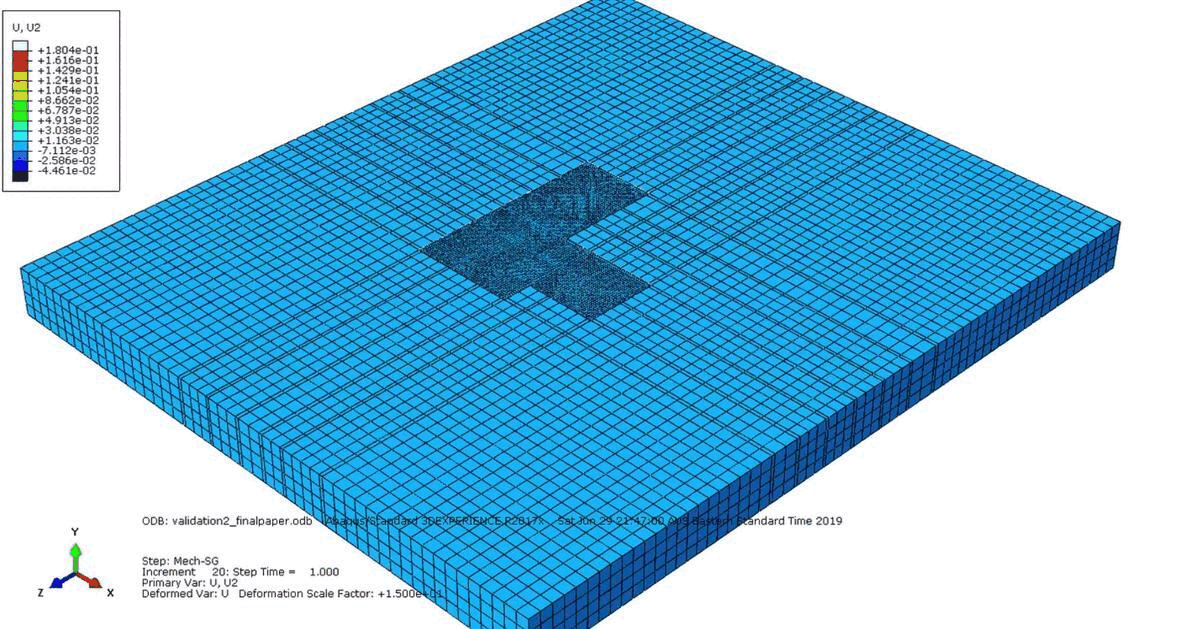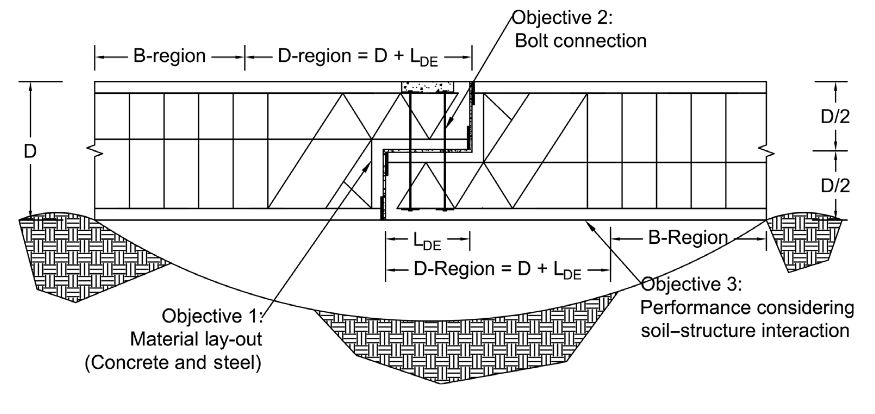Prefabrication of Residential Slab Foundation on Reactive Soil
Shallow footing systems are prone to damage due to the shrinking and swelling of the ground. A paradigm shift to a more sustainable design prompts this project to develop a practical three-dimensional finite element model to perform parametric simulations considering the soil and footing behaviour and interaction. This enabled a deeper understanding of the soil-structure interaction and improved the footing design accuracy. This model was further used to propose a novel method to design connections for prefabricated footings and to investigate their global performance and sustainability.
The graphic below shows the developed hydro-mechanical model that was used in the study to determine the behaviour of both soil and footing systems. This specific numerical simulation was based on the site inspection conducted by Jie Li, Donald Cameron and Gang Ren in Adelaide, Australia in 2014. The owner reported that the walls and ceilings of their house was cracking. Based on the inspection, the cracking was due to the differential movement of the reactive soil due to the stormwater and pipe leakages at the swelling ground area in the animation below. This had caused a differential movement of around 100 mm causing damage to both the superstructure and substructure of the house.

This project developed a connection for prefabricated residential slab foundaiton of single-detached dwellings on reactive soil using a combined soil-structure contact analysis and strut-and-tie model approach. The developed system was observed to have satisfactory performance, potentially overcoming most construction limitations of conventional monolithic cast-in-place raft substructures, such as faster, safer, and more sustainableconstruction,whileprovidingcomparable strength and serviceability.
A multi-criteria evaluation, using numerical simulations, life cycle cost (LCC) analysis, and life cycle assessment (LCA), observed that the developed prefabricated slab foundation performs better than conventional waffle rafts due to the optimised material layout and could be a more sustainable option when reusability is considered. Conversely, the cost of the prefabricated slab was higher than the conventional waffle raft due to the larger number of steel reinforcements required. The cost percentage difference can however be reduced to 5% when constructed on highly reactive soils with a larger house floor area. The prefabricated slab option can be viable to constructions requiring rapid substructure installations such as quarantine hotels, refugee camps, disaster accommodations, and large-scale commercial buildings.
Publications:
- Teodosio, B., Baduge, K.S.K. and Mendis, P., 2021. Design of prefabricated footing connection using a coupled hydro‐mechanical finite element model. Structural Concrete. (https://onlinelibrary.wiley.com/doi/full/10.1002/suco.202100315)
- Teodosio, B., Bonacci, F., Seo, S., Baduge, K.S.K. and Mendis, P., 2021. Multi-Criteria Analysis of a Developed Prefabricated Footing System on Reactive Soil Foundation. Energies, 14(22), p.7515. (https://www.mdpi.com/1996-1073/14/22/7515)
- Teodosio, B., Baduge, K.S.K. and Mendis, P., 2021. A review and comparison of design methods for raft substructures on expansive soils. Journal of Building Engineering, p.102737. (https://doi.org/10.1016/j.jobe.2021.102737)
- Teodosio, B., Baduge, K.S.K. and Mendis, P., 2020. Simulating reactive soil and substructure interaction using a simplified hydro-mechanical finite element model dependent on soil saturation, suction and moisture-swelling relationship. Computers and Geotechnics, 119, p.103359. (https://doi.org/10.1016/j.compgeo.2019.103359)
- Teodosio, B., Baduge, K.S.K. and Mendis, P., 2020. Relationship between reactive soil movement and footing deflection: A coupled hydro-mechanical finite element modelling perspective. Computers and Geotechnics, 126, p.103720. (https://doi.org/10.1016/j.compgeo.2020.103720)
- Teodosio, B., Kristombu Baduge, K.S., Mendis, P. and Heath, D.J., 2019. Prefabrication of substructures for single-detached dwellings on reactive soils: a review of existing systems and design challenges. Australian Journal of Civil Engineering, 17(2), pp.120-133. (https://doi.org/10.1080/14488353.2019.1657056)

